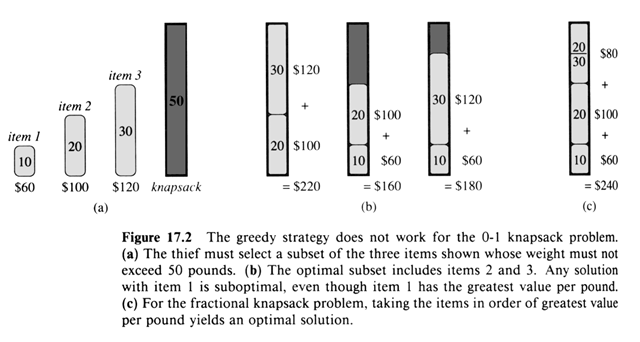Elements of the Greedy Strategy
Optimal Substructure:
An optimal solution to the problem contains within
it optimal solutions to sub-problems. A' = A - {1} (greedy choice) A' can
be solved again with the greedy algorithm. S' = { i Î
S, si ³ fi
}
When do you use DP versus a greedy approach? Which should
be faster?
The 0 - 1 knapsack problem:
A thief has a knapsack that holds at most W pounds. Item i
: ( vi, wi ) ( v = value, w = weight ) thief must
choose items to maximize the value stolen and still fit into the knapsack.
Each item must be taken or left ( 0 - 1 ).
Fractional knapsack problem:
takes parts, as well as wholes
Both the 0 - 1 and fractional problems have the optimal
substructure property: Fractional: vi / wi is
the value per pound. Clearly you take as much of the item with the greatest
value per pound. This continues until you fill the knapsack. Optimal
(Greedy) algorithm takes O ( n lg n ), as we must sort on vi
/ wi = di.
Consider the same strategy for the 0 - 1 problem:
W = 50 lbs. (maximum knapsack capacity)
| w1 = 10 |
v1 = 60 |
d1.= 6 |
| w2 = 20 |
v2 = 100 |
d2.= 5 |
| w3 = 30 |
v3 = 120 |
d3 = 4 |
were d is the value density
Greedy approach: Take all of 1, and all of 2: v1+ v2 =
160, optimal solution is to take all of 2 and 3: v2 + v3=
220, other solution is to take all of 1 and 3 v1+ v3 =
180. All below 50 lbs.
When solving the 0 - 1 knapsack problem, empty space lowers the
effective d of the load. Thus each time an item is chosen for inclusion we
must consider both
These are clearly overlapping sub-problems for different i's and so
best solved by DP!

|







